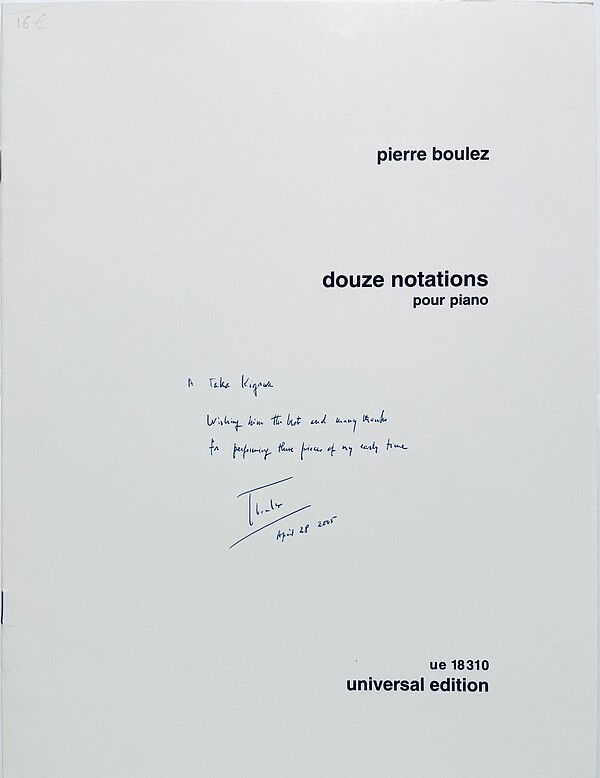Programs
Pierre Boulez: Douze Notations

Taka Kigawa in the video, Pierre Boulez on 12 Notations - Universal Edition
"Mr. Kigawa is always a poised guide through the most daunting music, as in his preternaturally unruffled evening-length survey of Pierre Boulez’s complete solo piano works." - Zachary Woolfe - The New York Times
"Playing with suavity and nuance, Taka Kigawa took the stage at Le Poisson Rouge last August with a daunting program: all of Pierre Boulez’s works for piano solo." - Zachary Woolfe, The New York Times
"The 'Notations' cast a particular spell. Brief — each of the 12 is just 12 bars long — and piquant, they offered Mr. Kigawa a full range of moods and effects: violently sliding in the second, elegiac in the fifth, rumbling and distant in the ninth." - Zachary Woolfe, The New York Times
"Debussy’s influence on Mr. Boulez seemed clearer than usual. And Debussy’s more puckish, mischievous side could be heard just below the surface of the faster movements of Mr. Boulez’s '12 Notations' (1945), even if the spare, sometimes mechanistic language reached toward a universe where Debussy sounded quaint." - Allan Kozinn, The New York Times
"This dynamic pianist has been especially acclaimed for his interpretations of daunting contemporary music. He has long made the solo piano works of Pierre Boulez a specialty in performances that bring out the exhilarating energy and myriad colorings in these fiercely difficult scores. In anticipation of Mr. Boulez’s 90th birthday in March, Mr. Kigawa has been on tour playing the complete Boulez pieces for solo piano in a single recital." - Anthony Tommasini, The New York Times
"Each of the twelve contrasting miniatures (the composer rewrote four of them for orchestra in 1978) remains self-contained like an epigram and, at the same time, open to dialog with the others. In reality, all of them derive from a single tone row and, for example, the chord that opens No 2 (“Tres vif”) is the same that closes No 9 (“Lointain-Calme”) and No 12 (“Lent-Puissant et âpre”). Kigawa, whose rhythmic sensibility is truly astonishing, proved to be a real master in revealing these recurrences, highlighting the reflections and exposing the hidden subtleties." - Pablo Gianera, La Nación
"His earliest piano work, the Douze Notations, is arguably his best one—quizzical, daring, fascinated with the piano. The music explores multiple ideas about consonance, dissonance, emotions, and more; Kigawa’s consistent thinking made it sound something like Schumann, episodes in a complete life, with beautiful phrasing in the 'Fantasque – Modéré' and 'Doux et improvisé,' and wit in 'Rythmique.'” - George Grella, New York Classical Review
"Douze Notations, a serial piece originally written in 1945 is comprised of 12 distinct sections, each barely a minute in length and containing a concise musical thought. (And, in what is a common theme throughout Boulez’s career, they are still being adapted, reworked, and expanded into a piece for orchestra.) Kigawa played through them seamlessly from the pointillist “Fantastique,” to the spritely “Rapide” and the restrained twelfth part “Lent,” merging these vastly divergent portraits into a wonderfully colorful and cohesive whole." - Amanda Angel, New York Classical Review
"Kigawa’s selection rescued a work from the pianistic pre-history of the French musician: the Douze Notations, which have practically disappeared from the catalog to return transformed into Notations for Orchestra. Even though they are based on a dodecaphonic row (the number twelve is omnipresent: each piece is also twelve measures long), they have a timbral beauty and bell-like sound that the sonatas casted aside, and that Kigawa explored masterfully. The Notations grew on a beautiful, ambiguous ground between impressionism and post-war serialism." - Federico Monjeau, Clarín
"Boulez's '12 Notations for piano' (1945) - played with bold, sensitive assurance by Taka Kigawa" - Donald Rosenberg, The Plain Dealer (Cleveland)
"Kigawa is not one to lock himself into one or two styles. We've heard him perform Debussy with all the nuance of the Frenchman's obsession with art that is antipathetic to the German approach. The oddly entitled Incises, is 'cut' out of mists and watery matter, le ruisseau of French valley, not the German Bach. Boulez, using the same title, has invoked his own contemporary sensibility. Still the two works of Boulez (Incises, Douze Notations) and the one by Murail (Mandragore) are descendants of Debussy's in their insistence on mysterious elements, though the two personalities are markedly different, Murail being more consistently playful in his musical notions than the often sterner Boulez. Kigawa seems to know them both intimately." - Barry L. Cohen, New Music Connoisseur
"The powerhouse pianist Taka Kigawa, who was on hand to play all of Pierre Boulez’s piano music—three Sonatas, the Notations and a few smaller works, 90-minutes of densely abstract music, all told—in one sitting, with no intermission, and from memory." - Allan Kozinn, The Wall Street Journal
"Mr. Kigawa’s sharp-edged, exquisitely transparent rendering of the Boulez canon (which won whistles and shouts) was offered." - Allan Kozinn, The Wall Street Journal